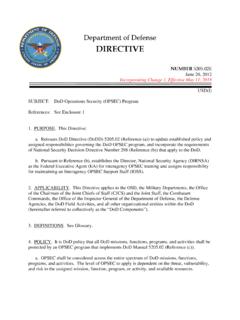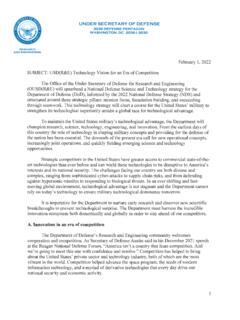Transcription of Defense Primer: Planning, Programming, Budgeting, and ...
1 Updated December 22, 2021 Defense primer : planning , programming , budgeting , and Execution (PPBE) ProcessIntroduction planning , programming , budgeting , and Execution (PPBE) is the Department of Defense (DOD) process for allocating resources among the armed services, Defense agencies, and other components. The annual process serves as the framework for DOD civilian and military leaders to decide which programs and force management requirements to fund based on strategic objectives. This product describes a notional PPBE process from the perspective of the Office of the Secretary of Defense (OSD). In practice, aspects of the process may differ based on current events or leadership preferences.
2 DOD Directive states that PPBE serves as the annual resource allocation process for the department over a multi-year planning cycle. According to the directive, the objective of the process is to provide the DOD with the most effective mix of forces, equipment, manpower, and support attainable within fiscal constraints. Chairman of the Joint Chiefs of Staff Instruction describes the process as the Secretary of Defense s institutional strategic planning system and the primary decision-making process for translating strategic guidance into resource allocation decisions. The process is designed to produce DOD s portion of the President s annual budget request to Congress, as well as updates to the department s five-year spending plan known as the Future Years Defense Program (FYDP).
3 PPBE is one of DOD s three main acquisition-related decision support systems, along with the Joint Capabilities Integration and Development System (JCIDS) for developing requirements to address capability gaps and the Defense Acquisition System (DAS) for managing acquisition programs. Background In 1961, then-Secretary of Defense (SECDEF) Robert S. McNamara established the planning , programming , and budgeting System (PPBS) as a framework for linking strategic objectives with resources. In 2003, DOD renamed the system PPBE in part to emphasize the need to better manage the execution of budget authority provided by Congress. The Deputy Secretary of Defense assists the SECDEF in the overall PPBE leadership role by managing the process on a day-to-day basis.
4 PPBE is a calendar-driven process that, for any fiscal year cycle, typically begins more than two years before the expected year of budget execution. Figure 1 shows when actions associated with a particular fiscal year cycle may occur during a calendar year. DOD sometimes makes a distinction between the execution phase of PPBE, or execution review, and the execution of congressional appropriations. (For more information, see the Execution section below.) PPBE Phases The PPBE process typically produces internal documents and materials for each phase. The planning phase produces the Defense planning Guidance (DPG), which details force development priorities. The programming phase generates a Program Objective memorandum (POM), a funding plan for each DOD component covering a five-year period that adjusts programs in the FYDP.
5 The budgeting phase results in a Budget Estimate Submission (BES), which covers the first year of the POM and converts programs into budget terms for submission to Congress. Figure 1. DOD Resource Allocation Process (notional) (fiscal year cycle by calendar year and month) Source: CRS graphic based on DOD references. Notes: CY: calendar year; FY: fiscal year cycle; Pro/Bud: programming / budgeting ; DPG: Defense planning Guidance; POM: Program Objective memorandum ; BES: Budget Estimate Submission. planning The Under Secretary of Defense for Policy leads the planning phase. The Chairman of the Joint Chiefs of Staff (CJCS) also plays a significant role in the process, in accordance with responsibilities as the principal military advisor to the SECDEF under Section 151 of Title 10, United States Code.
6 The CJCS s role is, in part, to advocate for solutions to department-wide requirements. The phase involves reviewing the President s National Security Strategy (NSS), the SECDEF s National Defense Strategy (NDS), and the CJCS s National Military Strategy (NMS) Defense primer : planning , programming , budgeting , and Execution (PPBE) Process to align the resulting Defense planning Guidance (DPG) with the Administration s policy goals and potential threats, force structure, readiness posture, and other factors. Developed with input from the CJCS, armed services, and combatant commanders, the DPG typically contains guidance on investments and divestments for the components and is intended to inform a component s Program Objective memorandum (POM).
7 programming The programming phase is meant to analyze anticipated effects of present-day decisions on the future force. The Director of the Cost Assessment and Program Evaluation (CAPE) Office leads this phase. The programming phase begins with the heads of each component developing a POM, which describes proposed resource requirements (forces, manpower, and funding) for programs over five years. Each POM prioritizes and adjusts programs in the FYDP, and also describes risks associated with underfunded or unfunded programs. Once each component submits a POM, CAPE leads the reviews of the programs, forecasts the resource requirements for the next five years, and updates the FYDP. As a result of program reviews, the SECDEF may direct the components to make changes.
8 budgeting The DOD Comptroller leads the budgeting phase, in which the components complete a Budget Estimate Submission (BES) for the first year of the FYDP. Using guidance from the Office of Management and Budget (OMB), the Comptroller reviews the budget submissions for funding and fiscal controls, phasing of the efforts over the funding period, and feasibility of execution within the budget year. During this phase, Comptroller analysts collaborate with component analysts to align budget requests with the overall Defense budget. As a result of budget reviews, the SECDEF may direct the components to make changes. The final product is typically submitted to OMB in December for inclusion in the President s annual budget request to Congress, which is usually submitted in February.
9 Execution During the execution phase, OSD and the components evaluate the obligation and expenditure of funds, as well as program results. The purpose of execution review is to assess program objectives against outcomes. The components assess compliance with priorities and SECDEF guidance, performance metrics, and program results. OSD staff review the assessments and recommend changes, in coordination with the CJCS and the Joint Staff. Other Key Players While each phase has a designated leader, that person and their staff collaborate with others during all phases of the PPBE process. Examples of these players and their designated roles include the following: USD for Research and Engineering (R&E).
10 Advises SECDEF on PPBE matters related to DOD research, engineering, and technology development activities and programs; ensures approved programs can be executed within fiscal and technical resources. USD for Acquisition and Sustainment (A&S). Advises on PPBE matters relating to acquisition and sustainment in the DOD (including system design, development, and production, and procurement of goods and services); ensures approved programs can be executed within fiscal and technical resources. USD for Personnel and Readiness (P&R). Advises on PPBE matters related to the total force ( , active and reserve military, civilian, and contract support), including planning , requirements, readiness, workforce mix, personnel policies, and health care issues.













